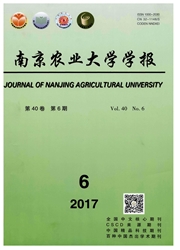

 中文摘要:
中文摘要:
利用Nipponbare/Kasalath//Nipponbare回交重组自交系群体,对贮藏在低温(4℃)和室温条件下的种子进行低温发芽率的观察和统计分析,利用Windows QTL Cartographer 1.16软件,对控制水稻种子低温发芽力的QTL进行检测。结果发现,低温发芽力QTL分布于第1、5、6、8、9和12染色体上,其中位于第5染色体上的qLTG-5(C597-R3166)和第9染色体上的qLTG-9(R79-C385)在低温萌发过程中持续表达。qLTG-5只在常温贮藏条件下稳定表达,表明此位点可能受种子贮藏条件的影响;qLTG~9在两种贮藏条件下均稳定表达,表明该位点不受种子贮藏条件的影响,可能与种子的耐贮性有关。研究结果可为低温发芽力强的水稻品种的标记辅助选择和图位克隆奠定基础。
 英文摘要:
英文摘要:
To gain an understanding of the genetic control of seed germination rate under low temperature conditions ( LTG), 98 backcross inbred lines (BIL) derived from a cross between a japonica variety Nipponbare and an indica variety Kasalath were used, which seeds were stored at low temperature (4 ℃) condition or room temperature environment. Quantitative trait loci (QTL) controlling LTG was analyzed by the software of Windows QTL Cartographer 1.16. The results showed QTL for LTG located on chromosome 1, 5, 6, 8, 9 and 12. Two putative QTL, qLTG-5 ( C597 - R3166) and qLTG-9 ( R79 C385), were detected to express stability in the whole germinating time, In which qLTG-5 expressed stably only stored in room temperature so that it maybe associated with seeds storage environment. Correspondingly, qLTG-9 could express stably stored at two different environments so it suggested this QTL could not be affected by seeds storage environment and related to seeds storable. Now, the closely linked markers on chromosome 5 and 9 could be used to facilitate the development of new rice varieties with high LTG ability and long longevity in marker-assisted selection (MAS) and thus to develop NILs (near-isogenic lines) for map based cloning in the regions.
 同期刊论文项目
同期刊论文项目
 同项目期刊论文
同项目期刊论文
 期刊信息
期刊信息
